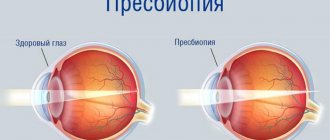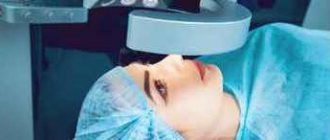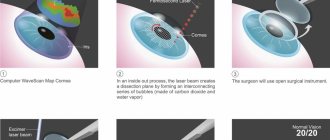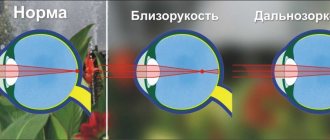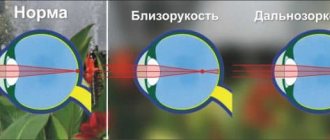73 / 100 Powered by Rank Math SEO SEO score
Farsightedness and nearsightedness are the most common vision defects that can appear at any age. Today they are observed in a quarter of the world's population. The causes of farsightedness and myopia can be different. The main causes and symptoms of these disorders differ in many ways. Common to both pathologies is a deterioration in the ability to clearly see surrounding people and objects at various distances.
What are the differences between farsightedness and myopia?
Myopia
Farsightedness
It is important to distinguish between myopia and farsightedness. Nearsightedness (myopia) is a condition in which the shape of the eyeball is elongated and the focus of the eye is shifted from the retina to the vitreous body. As a result, the organs of vision clearly perceive everything that is nearby, and poorly record distant objects. Visual perception is characterized by blurriness and fog. The main discomfort comes from the inability to see images, inscriptions, numbers, and people’s faces located even at a short distance from the eyes.
In simple words , farsightedness can be called the exact opposite of myopia. With this disorder, the eyeball is shortened, distant vision is sharpened, while activities performed close-up cause great difficulty. Farsighted people are uncomfortable working on a computer, have trouble reading, writing, or performing other similar activities.
Both violations cause a lot of inconvenience. In some cases, they can combine with each other, becoming the cause of astigmatism. This condition is characterized by blurred vision, rapid eye fatigue, and the development of headaches. Often, myopia that occurred at a young age turns into farsightedness over the years, which forces one to frequently change glasses or lenses. To detect farsightedness or nearsightedness at home, you need to hold a book at different distances from your eyes. If the text is equally readable, vision is still normal. If words are poorly distinguished when approaching and looking into the distance, this indicates the presence of pathology.
Myopia and its manifestations
Myopia, or, as experts say, myopia, is a common refractive error, which is characterized by poor vision of objects located at distant distances. At the same time, a person sees objects that are nearby well. The reason for myopia is that light beams are focused not on the retina, as with healthy vision, but in front of it.
The pathology develops gradually and can progress. Most often, school-age children are susceptible to myopia, when during the formation of the visual apparatus it is subject to a huge load - reading, writing, using a computer, gadgets, TV, etc.
Myopia severity can be:
- Weak - up to -3 diopters;
- Medium - from -3 to -6 diopters;
- High - from -6 diopters.
The occurrence of myopia is caused by the anatomical structure of the eyeball, when its anteroposterior axis is increased in size (axial myopia), failure to comply with hygiene rules, as well as damage to the components of the refractive system (lenticular myopia).
What is myopia
Nearsightedness, also called myopia, is a common vision defect in which a person can clearly see objects that are close to them, but objects that are in the distance appear blurry.
This occurs when an abnormality in the eye causes light rays to bend incorrectly, focusing the image in front of the retina rather than at its center.
Symptoms of myopia may include:
- blurred vision when looking at distant objects;
- headaches caused by eye strain;
- having to squint or partially close your eyelids to see clearly;
- excessive blinking.
Myopia
Myopia or myopia is a pathology in which objects located close to a person are clearly visible, and objects located far from him are reproduced blurred. In simple words, a person sees well up close and poorly at a distance.
A feature of the pathology is the gradual progression of decreased visual acuity if its cause is not eliminated. Over time, various complications may develop, which will inevitably lead to blindness.
There are several classifications of myopia. The main ones:
- Regarding the affected structure:
- Axial or axial. The reason is the extension of the eyeball in the anteroposterior direction, while the refractive function remains unimpaired.
- Lenticular. The reason is an increase in the refractive function of the lens, which develops against the background of certain diseases (diabetes mellitus) or taking medications (phenothiazine, chlorthalidone, hydralazine).
- Corneal damage. The reason is excessive curvature of the cornea and an increase in its refractive power.
- Taking into account the development mechanism:
- True. It develops as a result of organic damage to the eyeball, lens or cornea and can be either acquired or congenital.
- False or spasm of accommodation. It develops as a result of prolonged strain on the accommodation apparatus. This is a temporary phenomenon that disappears after eliminating the provoking factor. There is no violation of the integrity of the structures of the eyeball and the refractive system. At the same time, there is a risk of developing true myopia due to the long-term and often repeated influence of factors unfavorable for vision.
- Based on the reason:
- Hereditary. Occurs in a child if one or both of his parents have myopia. This also applies to asymptomatic carriers of the gene. The probability of developing pathology in a child is 25–100%.
- Acquired. It occurs throughout a person’s life and develops as a result of the influence of negative environmental factors.
There is another type of myopia - night myopia. It is observed in the dark or when the lights are off in the room and completely disappears in the light.
Causes
The causes of myopia are:
- Working at a computer or reading in dim lighting.
- Unfavorable working conditions.
- Insufficient intake of vitamins into the body (riboflavin or B2).
- Weakness of accommodation is a pathology that is expressed in the insufficient ability of the cornea or lens to refract light. As a result, the eyeball is elongated in the anteroposterior direction and causes myopia.
- Injuries involving damage to the lens, cornea or eyeball.
Features of the disease in children
Myopia in children is divided according to the mechanism of action into congenital and physiological.
| Name | Description |
| Congenital | It is observed in children born prematurely (up to 37 weeks). These babies have obvious curvature of the lens and cornea. As a result, light rays inside the eye are focused in front of the retina. This is the cause of congenital myopia. After a few months, it disappears on its own without requiring correction. |
| Physiological | Develops during increased growth of the eyeball between the ages of 5 and 10 years. During this period, the eyeball is stretched in the anteroposterior direction, which leads to focusing of light rays in front of the retina. This leads to myopia. Usually this process is completed when the child reaches adulthood, but sometimes physiological myopia progresses until the age of 25 |
Symptoms
At the initial stage of the disease, the main complaint is unclear reproduction of objects located in the distance. As the pathology develops, other signs appear. These include:
- Headache.
- Eye pain and burning.
- Tearing.
- Expansion of the palpebral fissure.
With prolonged progression of myopia, various complications develop. This usually concerns severe pathology.
Complications
Main complications:
- 1. Amblyopia - a decrease in visual acuity, in which one eye is completely or partially not involved in the visual process.
- 2. Strabismus - impaired coordination of the eyes and focusing on one object. With myopia, divergent strabismus is observed, characterized by a displacement of one eye towards the temple.
- 3. Cataract - clouding of the lens, the consequence of which is partial or complete loss of vision.
- 4. Retinal detachment from the inner wall of the eyeball. It leads to the death of light-sensitive cells and a decrease in vision until it is completely lost.
Cataract
Causes of farsightedness and myopia
Myopia most often begins to develop between the ages of 6-20 years. Students, schoolchildren, and people whose profession involves a lot of strain on the eyes are especially prone to it. The main causes of myopia:
- genetically determined predisposition;
- regular visual overload;
- head injuries;
- illiterate vision correction.
Farsightedness can be congenital, acquired, or age-related. This pathology often occurs in children under 3 years of age. During this period of life, it lends itself well to correction with glasses. At the age of 13-14 years, hypermetropia is diagnosed in 35% of adolescents. The causes of acquired hyperopia are ophthalmological or systemic diseases of the body. Farsightedness that develops in adulthood is considered a disorder that occurs due to natural causes. In such cases, the process is called “presbyopia”, and is associated with irreversible aging of the lens. It is interesting to know that the inhabitants of Japan are considered to be the most myopic. This pathology is diagnosed in 70% of the population of this country. Farsightedness is most common among Pacific Islanders and African Americans.
Correction of myopia and farsightedness with glasses
points. This is one of the most common and familiar methods for patients to correct refractive pathologies. Lenses for glasses are selected strictly based on the individual characteristics of a person’s visual ability only by a qualified specialist. But the patient can choose the frames himself. Fortunately, the modern optics market is replete with models of a wide variety of colors, shapes and materials and allows you to often change your look.
When presbyopia is detected in a person, two pairs of glasses are prescribed to correct vision not only near, but also at distance, since myopia accompanies the disease. However, there is a more optimal solution - bifocal or multifocal glasses with different optical properties.
Side effects
Herbal product. The main thing is the hepatoprotective effect. Flavolignans, incl. silybin, dehydrosilybin, isosilybin, silymarin, dehydrosilymarin, silychristin, tasifolin (2.8-3.8%) stabilize lysosomal and cellular membranes, preventing the release of enzymes from cells.
Interact with free radicals and inhibit lipid peroxidation processes. Thanks to the antioxidant effect, they inhibit the penetration of various toxins into liver cells (including chlorinated hydrocarbons, alpha-amanitin of toadstool, nitrosamines).
Silybin, silymarin and their derivatives stimulate specific RNA polymerase A, as a result of which the synthesis of proteins and phospholipids in hepatocytes is activated, and the processes of regeneration and detoxification in the liver are accelerated.
Tocopherols, macro- (potassium, magnesium) and microelements (copper, selenium) contained in fruits contribute to the normalization of metabolic processes. The fatty oil of the fruit (20-34%) contains a large amount of unsaturated fatty acids (incl.
linoleic acid - 50-62%), which have redox properties, promote the oxidation of cholesterol and, together with beta-sitosterol, prevent atherosclerosis. Mucus polysaccharides (5%) have an enveloping and gastroprotective effect.
The use of Karsil can cause such side effects as:
- Dyspeptic disorders (nausea, vomiting, feeling of fullness in the stomach, pain in the epigastric region, bloating, diarrhea);
- Allergic manifestations (rash, itchy skin);
- Alopecia (pathological hair loss, which leads to thinning or complete disappearance in some areas of the head or torso); exacerbation of vestibular disorders (if any).
Most patients and doctors leave positive reviews about Karsil; if adverse reactions occur, they disappear after stopping treatment.
Antitoxic, hepatoprotective.
As a rule, prevention or treatment using Karsil is tolerated without any complications or negative effects, only in rare cases or in cases of personal sensitivity, the following side effects were observed: nausea;
These negative phenomena are transient in nature and disappear without a trace after the end of therapy.
Karsil is an effective hepatoprotective drug. Silymarin, which is part of it, promotes the synthesis of structural proteins, stabilization of cell membranes, and normalization of lipid metabolism. The drug effectively protects liver cells from the harmful effects of free radicals and toxins.
The drug is produced by Sopharma (Bulgaria) under two names: Karsil and Karsil Forte (contains a large dosage of the active substance).
The drug Karsil is very well tolerated by patients. Side effects occur only in rare cases, in individuals with increased individual sensitivity to the components of the pill.
Side effects are expressed by the following clinical symptoms:
- Abdominal pain;
- Diarrhea;
- Flatulence;
- Allergic skin reactions.
As a rule, Karsil is quite well tolerated by patients, however, side effects can develop very rarely, the most common of which are:
- nausea;
- skin itching;
- diarrhea;
- allergic rash (occurs extremely rarely if there is an allergy to the main components of the drug);
- heartbeat disturbance (tachycardia or bradycardia);
- dry mouth;
- constipation;
- dizziness;
- loss of appetite;
- dyspnea.
If any of the above side effects develop, you must completely stop further use of the drug, and also be sure to consult a doctor!
In this article, we found out what Karsil helps with, as well as how to take it correctly.
General information
Myopia, farsightedness, astigmatism are three diseases of the visual organs that have the same nature. In order to understand them better, you first need to remember how the human eye works. Let us recall that the eye acts as a converging lens, that is, the rays entering it pass through the cornea and lens, as a result of which they are refracted and collected on the retina.
It is the image focused on the retina that we perceive as seen. Accordingly, if the focal point shifts for one reason or another, this leads to changes in vision. In one case, a person sees distant objects well, in another case, on the contrary, near objects. But myopia, farsightedness, and astigmatism are violations of normal refraction, that is, the ability of the eye to refract light.
So, what changes in refractive media can occur, and what do they lead to?
If the lens or cornea refracts light too much, the rays will converge not on the retina, but in front of it. In this case, myopia occurs, or, as it is also called, myopia. The same thing happens if the eyeball takes on an elongated shape, that is, the retina “moves away” from the focal point.
As a result, a person sees relatively well what is nearby, since a large number of rays are reflected from the object and the image is relatively clear. But distance vision is significantly reduced. Myopia is much more common than farsightedness and astigmatism and is a typical occupational disease in people who constantly work at a computer (the so-called computer syndrome).
There are several classifications of this eye disease. We have already mentioned one of them: refractive (with an increase in the refractive power of the lens or cornea) and axial (with a change in the optical axis). In addition, myopia, like other diseases, is divided into congenital and acquired. When monitoring a patient over time, myopia is divided into progressive and non-progressive.
Farsightedness has the opposite properties. Instead of being focused on the retina, the light rays are concentrated at an imaginary point behind the retina, meaning a blurred image appears on the retina. Farsightedness or, as it is also called, hyperopia, has the same classification as myopia. However, unlike it, a person can see well-distant objects, perceiving everything nearby in a “blurred” form.
Finally, astigmatism is a situation in which different areas of the eye have different refractive power. That is, light rays cannot focus at one point, since they are all refracted with different coefficients. Astigmatism can partly have the same properties as nearsightedness or farsightedness, depending on which direction the refractive index changes.
For complete coverage of this issue, we also note such a disease as age-related farsightedness. The fact is that with age, a person’s eyes lose their ability to accommodate, that is, quickly adjust the clarity of perception of the image of objects in different conditions. As a result, the eye cannot focus at close range. Of course, age-related farsightedness, although it has similar symptoms to normal farsightedness, differs from the disease of the same name by a slightly different nature. But it would be a mistake not to mention it in this article.
Degree of development of pathology
There are 3 degrees of development of myopia and farsightedness - weak, medium and high. For myopia they are classified as follows:
- 1st (weak) – the most common, the visual defect is no more than -3 diopters;
- 2nd (medium) – the disorder varies within -3-6 diopters, changes in the fundus become noticeable;
- 3rd (high) – deterioration in visual function exceeds -6 diopters, the risk of complications (cataracts, retinal dystrophy, glaucoma) increases.
The degrees of farsightedness are determined according to a different principle. With mild impairment of visual acuity, no visual acuity is observed, but patients complain of rapid eye fatigue, headaches, and dizziness. The examination results demonstrate a deviation from the norm of up to +2 diopters.
norm and pathology
The average degree makes it impossible to clearly see nearby objects; they become blurred. When you try to strain your eyes, headaches also occur. At the same time, distant vision remains within normal limits. The ophthalmologist detects a deviation of up to +5 diopters.
As a result of the development of a high degree, the eyes are equally unable to focus on objects located nearby or far away. The vision of a patient with hypermetropia is impaired to +5 or more diopters.
Symptoms and signs of myomia
The main symptoms of myopia are:
- Deterioration of distance vision.
- Blurred outlines of objects.
- The surrounding world literally merges.
- At the same time, good near vision will be maintained.
With myopia, a person has poor distance vision, the image of objects is blurred, but near vision remains good. Patients with a high degree of myopia see well almost right up to the nose, when the further point of clear vision lies not at infinity, but a few centimeters from the eye. You've probably seen people who, having taken off their glasses, literally “rest their nose” on the object they are looking at.
Signs of myopia, when it is combined with various types of astigmatism, are not only the blurring of the image, but also:
- double vision;
- distortion of objects;
- straight lines may appear curved.
If eye myopia begins to develop in adulthood, it can occur without symptoms for a long time, and often a person learns about visual impairment during a preventive examination. In childhood, the first signs of myopia, as a rule, appear with the beginning of educational activities.
The child is less able to distinguish objects in the distance, has difficulty seeing the lines on the board, and complains of a headache. Also, with myopia, weakening of twilight vision is observed. With this condition, a person notices difficulties with orientation in the dark.
According to many ophthalmologists, its long-term presence contributes to the growth of the anteroposterior size of the eyeball and true myopization of the eye.
The most dangerous complication of myopia is retinal detachment and blindness. In order to prevent irreversible damage, it is important to recognize the first prerequisites in time and take appropriate preventive measures.
What is farsightedness
Hyperopia, also called farsightedness, is another common vision defect in which nearby objects appear blurry, but vision becomes clearer when a person looks at distant objects.
Typically, the degree of farsightedness affects the ability to focus. Severe farsightedness may cause one to see clearly only objects that are far away, while a person with mild farsightedness can also see objects that are nearby clearly.
- FAQs Eye like an eagle: 8 basic rules for healthy vision (simple and not boring)
Symptoms of hypermetropia may include:
- blurred vision when looking at close objects;
- eye strain, including burning and pain in or around the eyes;
- general eye discomfort.
Correction of myopia and farsightedness using contact optics: advantages
disposable lenses that do not require maintenance, as well as contact correction products that you can sleep in or wear without removing them for several days.
Contact optics also allow you to correct severe degrees of myopia, farsightedness and presbyopia.
But despite all the above-described advantages of this type of vision correction, if you choose scheduled replacement lenses, it is very important to take proper care of them and follow the hygiene rules prescribed by the ophthalmologist.
Diagnosis of eye diseases
The traditional and main method for diagnosing myopia and farsightedness is a study using ophthalmological tables. Deviations more or less from the norm are interpreted as visual impairment. To identify myopia and determine its level, specialists also resort to:
- measuring the length of the eyeball using echobiometry (ultrasound examination);
- determination of eye refraction and degree of myopia;
- ophthalmoscopy (studying the condition of the fundus, retina, optic nerve).
Vision diagnostics
When examining for farsightedness, patients are shown:
- testing using a table;
- eye accommodation study;
- tests for vision loss;
- studies of bipolarity of the eyes.
Additional tests may be used to determine whether it is nearsightedness or farsightedness. If an operation to eliminate vision defects is planned, aberrometry and various tests are prescribed.
Diagnosis of myopia
The diagnosis of myopia is made by an ophthalmologist after checking visual acuity using special tables. The fundus is also examined with a special mirror. Before this procedure, the patient is usually given a medication that dilates the pupils by dropping them into the eyes. These are traditional procedures.
A complete examination includes:
- accurate determination of the patient’s visual acuity and refraction,
- measurement of intraocular pressure,
- conducting an eye examination under a microscope (biomicroscopy),
- pachymetry (measurement of corneal thickness),
- echobiometry (determination of eye length),
- ultrasound examination of the eye,
- computer keratotopography and a thorough examination of the retina (fundus of the eye) with a wide pupil,
- determining the level of tear production,
- detailed examination of the patient's visual field.
The main vision problems in children develop before the age of 7 years. After 7 years, the child’s visual system begins to experience increased stress associated with studying at school. It is during this period that diseases that were not noticed or prevented before begin to develop.
After 12 years of age, vision problems usually cannot be treated. It will be possible to eliminate myopia and astigmatism in a teenager only after the age of 18, when the young person can undergo laser vision correction.
But a correct and timely forecast of vision development in some cases makes it possible not to put glasses on a child at all. In order to correct his vision, it will be enough for him to undergo a therapeutic course of treatment. For an accurate diagnosis of vision, you should contact the children's departments of ophthalmology clinics, and only those that have special diagnostic equipment.
After a thorough and complete examination, the doctor conducts a conversation with the patient and, based on all the data, prescribes treatment.
Indications for use
What does Karsil help with? According to the instructions, the drug is prescribed in the following cases:
- toxic liver damage;
- condition after hepatitis;
- chronic hepatitis of non-viral etiology;
- liver cirrhosis (as part of complex therapy);
- liver steatosis (non-alcoholic and alcoholic);
- for the purpose of prevention during long-term use of medications, alcohol, and chronic intoxication (including occupational).
The drug is not used for the treatment of acute intoxication.
What does it help with? Karsil is prescribed for the following diseases:
- Toxic liver damage.
- Chronic hepatitis of non-viral origin.
- Liver cirrhosis (as an additional remedy).
- Chronic intoxication, as well as liver steatosis (both alcoholic and non-alcoholic).
The use of Karsil is effective as a prophylactic agent during long-term drug therapy and prolonged alcohol consumption.
Indications for the use of Karsil are toxic liver damage in patients with cirrhosis of the liver and its chronic inflammatory diseases.
Prevention of myopia
If myopia is present, treatment and prevention should be carried out in parallel. If you follow simple rules, you can prevent and significantly slow down the development of myopia. To do this you need:
- Proper lighting of the workplace. On the desktop, the light should not be very bright or weak. It is necessary to make it comfortable for the eyes to look at. The best option is obtained by combining general and local lighting.
- Dose visual load. With prolonged visual work, the tear film on the surface of the eyes dries out due to infrequent blinking, causing pain and a burning sensation. In addition, false myopia, a spasm of accommodation, may occur due to eye fatigue. In order to avoid these troubles, it is necessary to take breaks during long-term work.
- Correct reading. This should not be done in a lying position, the text is at the wrong angle to the axis of vision, or in a moving vehicle. The eyes get tired because the focus changes all the time. The correct position for reading is sitting, when the distance to the reading surface is 30–40 cm.
- In winter and spring, when the supply of vitamins in the body runs out, they should be replenished by taking vitamin-mineral complexes.
- Systematically do gymnastics for the eye muscles.
Preventive measures are especially effective in childhood.
Treatment methods
The therapeutic regimen for treating myopia and farsightedness is not capable of completely restoring full vision and has only a short-term positive effect. The result of taking vitamins (Riboflavin, Visiomax, Lutein complex) and doing special gymnastics can be the relief of some symptoms and the prevention of further development of pathology. Medicines to support visual function in patients with myopia or hypermetropia (Focus B, Quinax, Emoxipin) improve blood circulation in the visual organs, relieve fatigue and protect against harmful external influences. The only effective way to restore full visual function is correction. She may be:
- spectacle;
- contact;
- surgical.
The main goal of all types of correction is to ensure normal focusing of the image on the retina. In case of myopia, this will require a decrease in refraction (refraction of rays), and in case of hypermetropia, it will require an increase.
Contact lenses
Glasses are often prescribed at the initial stage of the disease, or when the use of other methods is unacceptable. This type of correction is the most common and accessible. Its main advantage is the rare development of complications, the ability to simulate and change the strength of correction. The main disadvantage of wearing glasses is their inability to form a single optical system with the eye. Contact correction involves wearing lenses of varying degrees of hardness. The advantages of their use are a complete overview, greater visual acuity, image clarity and a minimal list of contraindications. Contact lenses are not able to restrain the progression of visual impairment and relieve them. Their main function is to reduce eye strain and normalize the functioning of the visual organs. Modern manufacturers offer a large selection of such products: night, color, tint. Surgical correction is recommended for continuous progression of pathology or exacerbation of symptoms. This method is aimed at changing the entire refractive power of light, completely restoring vision, and gaining the opportunity to refuse to wear optical devices (glasses, lenses). For farsighted or nearsighted pathology, various laser correction methods are used (photoreactive keratectomy, LASIK, FEMTO-LASIK, etc.). Correction methods using laser make it possible to improve vision within 1-2 hours, and fully restore it after 2-3 weeks. The disadvantage of surgical correction is its high cost and a considerable list of contraindications.
Farsightedness
Farsightedness or hypermetropia is an eye pathology in which the image is focused behind the retina. As a result, a person sees poorly near and well at a distance.
The cause of farsightedness can be either a damage to the light refraction system or an irregular shape of the eyeball. The main reasons for the development of pathology are a violation of the refractive system of the eye and structural features of the eyeball.
Classification.
| Name | Description |
| Physiological in children | Almost all newborn children have physiological farsightedness. The reasons for this are the structural features of the eyeball (it is more rounded) and the slight curvature of the cornea. All this leads to focusing the light beam behind the retina |
| Congenital or pathological | The reasons are deviations in the development of the eyeball and the light refraction system. These include: irregular apple shape or small size, flat cornea, incorrect location of the lens, its small size or complete absence |
| Acquired | It develops when the size of the eyeball decreases in the anteroposterior direction or due to damage to the lens and cornea. Causes: eye injuries, tumors near the orbit, removal of the lens, consequences of eye surgery, cataracts and others |
| Age (presbyopia) | The basis of age-related or senile farsightedness is a violation of the structure and functioning of the lens. This is due to the gradual compaction of the core of this organ and its loss of elasticity. Typically, pathological changes in vision occur after the age of forty and reach their apogee by the age of sixty |
Symptoms
Signs of hypermetropia:
- Fuzzy vision of nearby objects.
- The process is aggravated by dim lighting and attempts to read books - this requires moving the book a certain distance.
- Discomfort in the eyes while reading and when working with small parts.
Symptoms accompanying farsightedness:
- Fast fatiguability.
- Burning and stinging in the eyes.
- Head and eye pain.
- Tearing.
- Photophobia.
Manifestations of the disease appear some time after the start of working with objects located at a short distance and disappear after the process is completed. The duration and severity of symptoms are determined by the degree of hypermetropia - the higher it is, the more pronounced the clinical picture.
Complications
The progression of pathology can lead to a number of complications:
- 1. Strabismus. This complication occurs in both myopia and hypermetropia. The difference is that with farsightedness, convergent strabismus is observed - the deviation of the pupils towards the bridge of the nose. The reason for this is the long process of accommodation, that is, tension of the ciliary muscle and normalization of the refractive function of the lens.
- 2. Amblyopia.
- 3. Accommodation spasm is a prolonged contraction of the ciliary muscle, that is, its spasm.
Convergent strabismus with hypermetropia
Clinical and pharmacological group
Antitoxic, hepatoprotective effect.
Karsil is well tolerated by patients. Side effects from it are extremely rare and go away on their own after you stop taking the pills. In some cases, the drug may cause the patient to:
- intestinal disorder;
- discomfort in the abdominal area;
- nausea;
- vomiting;
- hair loss;
- strengthening of existing vestibular disorders;
- allergic manifestations (urticaria, itching, rash).
If adverse reactions occur, the patient should stop taking Karsil and contact their doctor with a request to choose a more appropriate method of treatment.
An overdose of Karsil does not pose a danger to the patient’s life. Taking the drug in large quantities can lead to a deterioration in general health, headache, nausea and intestinal upset.
There is no data on the effect of Karsil on the speed of psychomotor reactions in humans. The drug does not have a noticeable negative effect on the central nervous system, so during the period of its use the patient does not need to give up driving or performing work that requires concentration and attention.
MORE ABOUT: Does a massager help remove belly fat? Answer!
Before starting treatment with Karsil, it should be taken into account that the silymarin contained in the composition can interact with other drugs. It enhances the therapeutic effect of psycholeptics, anticoagulants, hypolipidemics, antifungals, antihistamines and antineoplastic agents.
During the period of using Karsil, the patient should refrain from drinking alcoholic beverages and using medications containing ethanol. Alcohol has a negative effect on the liver and minimizes the therapeutic effect of the hepatoprotector.
Karsil is intended for free sale; it can be purchased at any pharmacy without presenting a medical prescription. The drug should be stored at room temperature out of the reach of children and protected from moisture and sunlight. The shelf life of the medicine is 24 months from the production date indicated on the cardboard box.
Diagnosis and treatment of myopia
Any treatment is preceded by diagnosis. As noted at the beginning of the article, a person can determine the presence of myopia on his own. The main symptom is a blurry picture that the patient sees when looking into the distance. But only a specialist can establish its type, degree and causes of occurrence. In some cases, this will require an ultrasound. Therefore, if you find signs of myopia, you should consult a doctor.
Treatment methods for myopia
In modern medicine, there are several ways to get rid of myopia. These include non-surgical correction, surgical and laser methods of vision restoration. The first includes wearing glasses and contacts. In this case, as you might guess, the problem is only partially solved. Vision improves only while wearing optical products.
The most modern and safe way to treat myopia today is laser correction. Using a laser, the specialist changes the shape of the cornea, making it flatter. Simply put, the laser beam forms a minus glass in the cornea. Like glasses, it scatters light and the image hits the retina, providing good vision.
Prevention of violations
In order to prevent the development of disorders, you should adhere to the basic rules of prevention:
- include in your diet foods that benefit your vision (carrots, pumpkin, blueberries, eggs, pure dark chocolate, fish oil);
- avoid excessive stress and eye injury;
- perform special exercises to stimulate visual function and relieve tension;
- provide comfortable lighting during the work process;
- to live an active lifestyle.
Regular preventative examinations with an ophthalmologist will allow you to identify the presence of pathology in the early stages and solve the problem as painlessly as possible.
What is farsightedness and its symptoms, differences from myopia
Farsightedness or hypermetropia is a completely opposite process. The only thing that unites these concepts is that these terms refer to problems with the function of the visual apparatus.
It is believed that such vision problems are preferable to myopia, but this is not at all true.
Congenital and acquired hyperopia is a pathological condition that requires mandatory medical correction.
Causes
Causes of farsightedness:
- Age-related changes in the retina.
- Physiological features of the ocular apparatus (elongation of the eyeball and others).
- Consequences of injuries and chronic diseases.
One of the most indicative symptoms of farsightedness is rapid eye fatigue when reading or other work that requires concentration.
Patients complain of frequent inflammation of the eyes, and may also experience discomfort and burning. Read this material on how to use the Synoptophore device at home.
There are the following types of myopia:
- Mild hypermetropia. The deviation is up to two diopters with a positive value.
- Average degree. Characterized by the need for correction in the range from 2 to 5 diopters.
- Severe hypermetropia. In this case, a difference of over five diopters is revealed.
The necessary examinations and inspection will reveal possible violations. Especially often, the development of farsightedness occurs under the influence of age-related changes. Find out about the instructions for using Brimonidine eye drops at this link. It is advisable for people over 40 to undergo an annual preventive examination by an ophthalmologist, even without special “reasons” to prevent the development of such pathologies.
On video: what is farsightedness
Correction and treatment
In addition to the methods described above for treating myopia, which are also suitable for this case, there are several more ways to restore vision.
Popular techniques for farsightedness:
- Laser thermokeratoplasty. The operation for farsightedness and myopia is carried out using special equipment, is painless and does not require long-term rehabilitation. The method is based on heating the collagen fibers of the eye, which changes the shape of the cornea.
- Replacing the lens of the eye. Typically, indications for such intervention are irreversible damage or wear of the lens.
- Positive value lens implantation. It is also a relatively new method that has earned many good reviews from doctors and patients.
On video: how to determine myopia or farsightedness, test
Use during pregnancy and lactation
There are no data on the safety of taking the drug during pregnancy. Karsil can be used in the treatment of a pregnant woman only for special indications. At the same time, the expectant mother must be constantly under medical supervision.
Treatment with Karsil is also not recommended during breastfeeding. If the product is used, it is necessary to stop lactation and transfer the child to artificial feeding.
At the moment, all potential complications of silymarin in relation to the fetus, expectant mother and infants have not been studied, and therefore it is unknown what exact consequences Karsil tablets can lead to during pregnancy and lactation, for which reason they are not prescribed during these periods.
How can myopia be cured?
Myopia is the most common refractive error, affecting approximately 1.5 billion people worldwide, representing about 23% of the population. Scientists say that in 30 years, half of the world's people will have some degree of myopia. What is this connected with? There are a number of factors that contribute to vision deterioration. These include:
The content of the article
What is myopia
- Causes of myopia
bad ecology;
It is practically impossible to prevent myopia if it is caused by a hereditary predisposition, but today it is possible to stop the development of the disease and cure it. There are several main methods of treating myopia:
- doing eye exercises;
- taking courses in hardware procedures;
- taking vitamin complexes;
- vision correction with glasses and contact lenses;
- laser treatment;
- refractive surgery.
The last two methods allow you to get rid of myopia forever or for a very long time, but they are prescribed only to adult patients. Why can’t vision correction surgery be performed on children? To answer this and other questions related to the treatment of myopia, it is necessary to describe this disease in more detail.
